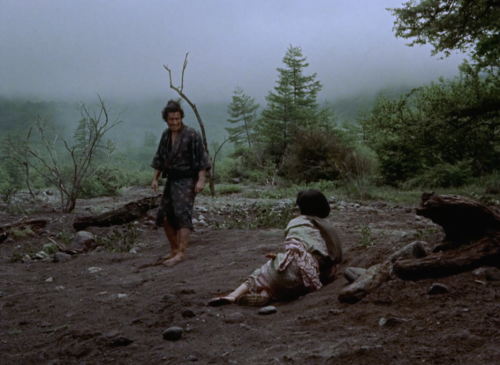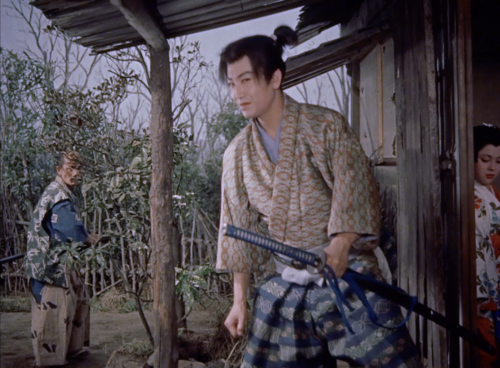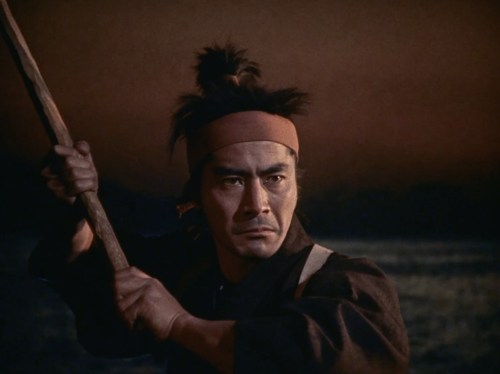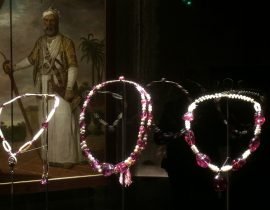
LA LÉGENDE DE MUSASHI

DUEL À ICHIJOJI

LA VOIE DE LA LUMIÈRE
Musashi is a trilogy consisting of the films The Legend of Musashi (1954), Duel at Ichijoji (1955) and The Way of Light (1956). These three feature films are among the best-known Japanese works in the world, thanks to the Oscar won by the first episode and to their international distribution at the time of their production. Directed by Hiroshi Inagaki, the trilogy is an adaptation of The Stone and the Sword and The Perfect Light, novels that first appeared in serial form in the 1930s and are among the most widely translated Japanese literary works abroad. These works are the fictionalized version of the adventures of the samurai Miyamoto Musashi, the illustrious seventeenth-century warrior who now has a statue in Kyoto and several provinces in Japan.
This book looks back at the extraordinary life and destiny of the famous samurai, but also at the spectacular film saga conceived by Hiroshi Inagaki, one of the masters of the sword film.
Miyamoto Musashi’s international legend is recorded under his Japanese name (surname, then given name), so this is how he is referred to in the following pages. Other personalities are mentioned in Western order (e.g. Toshiro Mifune).
Miyamoto Musashi is Japan’s most famous samurai. His story, but especially the legends surrounding him, are an integral part of the popular culture of the archipelago. There are few people who do not know his name and who could not tell at least some of his exploits, whether real or fictional. This warrior, with his iconoclastic personality and attitudes often not conforming to those one would expect from a samurai, still occupies a special place in the national pantheon and remains a source of inspiration for many artists and intellectuals. His writings, teachings and many of his works of art have survived to the present day and still infuse contemporary Japanese society.
This cultural influence is partly due to the wide distribution (both nationally and internationally) of the Gorin-no- sho1, the most famous and most accomplished of the five works Musashi composed, which is still one of the most widely read and studied books on combat methods and military strategy in the world. The great strength of this treatise lies in the fact that its scope is not limited to the world of martial arts. This work, although it explains certain techniques in detail and sometimes seems to be aimed solely at fighters, is not limited to the martial arts, is in reality above all a metaphysical treatise, a poetic work offering a profound reflection on art, the human condition and the meaning of existence.
Miyamoto Musashi is, above all, a historical figure who really existed. He was a skilled swordsman who won many duels, a master of swordplay and strategy, but also a painter, sculptor, calligrapher, philosopher and poet. Although little reliable historical evidence of the various stages of his life has come down to us, it is safe to say that during his lifetime his influence on the history of his country, especially in the field of martial arts, was considerable.
Barely a year after his departure, in 1600 and aged just sixteen, he took part in three major battles, including one of the most famous in Japanese history, the battle of Sekigahara. The two great clans that wished to rule Japan without division clashed: the Tokugawa forces against those loyal to the Toyotomi. It is estimated that each army has about 80,000 men, who fight each other relentlessly for more than twenty-four hours. Musashi, who was one of those who The loser – Toyotomi – has to flee after the defeat, and his whereabouts are lost. He resurfaced in historical documents in 1604, at the age of twenty. That year, it was not an opponent that he fought, but an entire clan: the Yoshioka. Musashi, in order to prove his worth and to progress in the art of swordsmanship, challenges the main master of this powerful clan, the elder brother, Seijuro Yoshioka, to a duel. In order to secure victory, he opts for a strategy based on cunning, which some might even call disloyal. But Musashi, as the rest of his adventures will confirm, does not bother with these ethical questions: only victory counts. Kill or be killed. To become the best swordsman in the archipelago or to perish.
To provoke his opponent in order to psychologically destabilize him, the young swordsman decides to arrive deliberately late for the duel. Irritated and distracted when Musashi finally makes his entrance, Seijuro Yoshioka is smashed in the shoulder with a single blow of his wooden sword. He loses the use of his left arm: handicapped and disgraced, he immediately decides to leave the clan and become a monk. Seijuro’s younger brother, Denshichiro Yoshioka, takes over the clan. He demands revenge and hastens to challenge Musashi to a duel. Speculating on the state of impatience and excitement in which a brother must find himself who wants to avenge his family’s honour at all costs, he decides to arrive late again. This ruse works again: Denshichiro is very annoyed when his opponent finally shows up. During the fight, his weapon is snatched away and Musashi uses it to split his skull in two.
The historical Miyamoto Musashi has become over time a legendary, almost mythological figure, central to Japanese popular culture, especially from the inter-war period onwards. This character obviously draws its source from the various biographical elements that have come down to us as well as from the writings that Musashi left to posterity. But the Musashi whose exploits we tell ourselves about, whose adventures we admire in the cinema or on television, whose adventures we devour page after page in a series of mangas, is more of a fictional character than the real person who inspired him, so much so that the various works that recount his existence are often far removed from the attested facts.
We know that as early as the eighteenth century – only a few decades after his death – and throughout the nineteenth century, Musashi’s most famous duels were already successfully staged in the theatre. Numerous manuscripts also circulated among scholars, telling with emphasis this or that feat of the warrior. Printmakers magnify him, depicting him valiantly fighting monstrous and legendary animals – a giant bat or lizard for example. The storytellers who travelled the country also seized on the character’s exploits and, with much exaggeration, helped to forge his legend.
In all these works or stories, the (already spectacular) reality of the historical facts is, of course, strongly undermined and the samurai’s exploits are largely amplified or invented from scratch. The fight against the Yoshioka clan on the plain of Ichijoji and the duel with Kojiro Sasaki are the most common events in these stories.
Historians estimate that some sixty feature films featuring Musashi as a hero have been produced in Japan from the beginning of the 20th century to the present day – even though some of these films are unfortunately now lost, especially those produced before the Second World War. In addition to these cinematographic works, we must add all those in which Musashi is only a secondary character, but also short films, television series, animated series and TV films! Musashi is thus one of the most recurrent historical figures on Japanese screens.
Proof of this preponderant place, the greatest actors of sword films have, in turn, incarnated this warrior (notably Chiezo Kataoka, Toshiro Mifune and Kinnosuke Nakamura) and important directors have adapted his adventures (for example Kenji Mizoguchi, Daisuke Ito, Kunio Watanabe or Tai Kato), and sometimes even devoted a substantial part of their filmography to it (eleven films for Hiroshi Inagaki and six for Tomu Uchida).
The first film production to feature Musashi was a puppet film dating from 1908, inspired by the prints that showed the character fighting monstrous creatures: Miyamoto Musashi Hihi Taiji no Ba (which could be translated as The Extermination of Hihi by Miyamoto Musashi – Hihi being a legendary great mountain monkey, a Japanese equivalent of the Yeti). Many other films were made in the 1910s and 1920s, notably for major studios such as Nikkatsu (which produced four films, all entitled Miyamoto Musashi, in 1914, 1918, 1921 and 1924) or Shochiku (Miyamoto Musashi, 1921). As all these works are now considered lost, it is difficult to know how many were filmed exactly and how Musashi was portrayed in them. Many of them, like the first one from 1908, were inspired by eighteenth- and nineteenth-century prints and featured spectacular battles with fantastic creatures.
But while Yoshikawa’s serial was still being published (it was published between 1935 and 1939), several film adaptations were already being produced. The way in which this samurai is represented on the screen is going to be turned upside down. These include Miyamoto Musashi (Ryuza Otomo, 1936), Miyamoto Musashi: The Book of the Earth (Jun Ozaki, 1937) and Miyamoto Musashi: The Book of Wind (Seiichi Ishibashi, 1937). After 1939 and the end of the publication of the serial, the vast majority of films devoted to Musashi were adapted directly from Yoshikawa’s work, even if it is interesting to note that each director was able to appropriate the character and model him in his own way. Thus, all these feature films, although taken from the same work, offer sometimes radically different interpretations of Musashi and his personality: calm, sensitive and almost hieratic in Mizoguchi; a paragon of bravery, uprightness and courage in Inagaki; complex and dark in Uchida; violent and unstable in Kato, etc.
The first emblematic actor of the Japanese sword film, who was also a great star of the Kabuki theatre, to have incarnated this samurai in the cinema is Chiezo Kataoka. He played the role of Musashi seven times for the big screen, between 1929 (in Miyamoto Musashi directed by Kintaro Inoue and produced by the actor himself) and 1957 (in the two parts of Kojiro Sasaki, directed by Kiyoshi Saeki and produced by Toei). He played him in the first trilogy dedicated to the character by director Hiroshi Inagaki, produced in 1940, as well as in his 1942 film about the battle of Ichijoji against the Yoshioka clan, all produced by Nikkatsu and adapted directly from Yoshikawa’s work.
The second emblematic actor to have played this warrior is Toshiro Mifune. He played the role of Musashi in two trilogies, directed by Hiroshi Inagaki and always adapted from Yoshikawa’s series. The first was Kojiro Sasaki (1950-1951) and the second Musashi (1954-1956, a Toho blockbuster).
After the popular and international success of the Musashi trilogy, other major studios produced their own adaptations. Daiei produced two, in 1956 and 1960. Shochiku also produced two, in 1959 and especially Tai Kato’s Miyamoto Musashi in 1973, which unfolds a violent and nihilistic vision of the samurai’s life, graphically splendid. Toei produced a first film in 1956, then a diptych in 1957 and finally a magnificent pentalogy directed by Tomu Uchida between 1961 and 1965 with Kinnosuke Nakamura in the
Musashi’s role: the best film adaptation of Yoshikawa’s novel with Hiroshi Inagaki’s trilogy, the two cycles being finally quite complementary in their approach to the character.
In the 1980s and 1990s, the character’s appearances on the big screen became much rarer, but it should be noted that swordplay films were much less in vogue in the film industry than in the previous decades. Yoshikawa’s serial was however regularly adapted for television, notably in a series broadcast between 1984 and 1985 where the then still little known actor Koji Yakusho played Musashi in 45 episodes.
Distributed for the first time in France in August 1993 (almost forty years after its Japanese release), Hiroshi Inagaki’s Musashi was one of the great successes of the heritage cinema that summer, notably on the giant screen of the Max Linder Panorama in Paris. Nothing really surprising when you consider that the two-part translation of the novel at the origin of this saga had already been popular in bookshops for a decade. Thus, the French public finally discovered in theatres one of the jewels of adventure cinema such as the Japanese studios were producing in the 1950s. For film lovers all over the world and for martial arts enthusiasts, this spectacular trilogy is mythical, and alone represents the golden age of Asia’s greatest filmography
When the American occupation forces took control of the Japanese film industry in the aftermath of the war, not a single feature film was made without its script being translated into English and then screened by the occupying forces. Among the instructions was to encourage works set in the Japan of reconstruction (films belonging to the gendai geki genre) and to view those set in feudal Japan (the jidai geki) with the greatest suspicion. From now on, nothing in the cinema should exalt the tradition and mores of the past. Make way for the values of democracy and cultural products from the West! Japanese films in costume became rarer from 1945 onwards. As for the samurai characters, there was no need to think about them: their ideals, steeped in the precepts of Bushido, were outlawed. Wasn’t it these samurai and their sense of sacrifice that were held up as models to young men enlisted for war? The Americans no longer want to see them in the cinema. Japan must look to the future, not the past. The first virtue of this new specification is that Japanese cinema will become spectacularly feminine, and from now on women will also take centre stage. – Something that had not happened, or almost not happened, since the 1930s. Setsuko Hara espouses the anti-militarist cause and then the peasant cause in Akira Kurosawa (I regret nothing of my youth, 1946), Kinuyo Tanaka plays a temperamental lawyer in Kenji Mizoguchi’s (Women’s Victory, 1947), Yumeji Tsukioka is a peacekeeper for Kazuo Mori (Policewomen, 1947) and Hideko Takamine organises a strip-tease in her native village under the mischievous eye of Keisuke Kinoshita (Carmen Returns, 1951). No, really, the samurai are no longer welcome, they are part of daddy’s cinema, and therefore of the old world. In the studio’s “accessories” department, the swords were put back in the wardrobe.
This censorship was officially lifted in the autumn of 1949, but the American offices in Tokyo continued to keep an eye on the country’s film activity. Productions were still evaluated by the occupiers before being allowed to be released. Nevertheless, in December 1950 Kojiro Sasaki was released, the first part of a trilogy dedicated to Kojiro, Musashi’s famous enemy. Directed by Hiroshi Inagaki, a filmmaker considered a major figure at Toho, this film revived the cham-bara (sword film) at the studio. The public was ecstatic, and Kojiro Sasaki was the company’s biggest success that year. At last the samurai are back! A few months later Akira Kurosawa, screenwriter, and Kazuo Mori, cinematographer, put together The Vendetta of a Samurai: Duel at the Corner of Kagiya, which was released in January 1952, starring Toshiro Mifune. The Kojiro Sasaki trilogy, meanwhile, has just seen its second and third installments triumph… with Mifune appearing as Musashi in the final film.
When he won the Golden Lion in Venice in 1958 with The Man with the Rickshaw, Hiroshi Inagaki spent the evening with Louis Malle and Sophia Loren. Touched by the thoughtfulness shown to him by the Italian actress and the French filmmaker, the filmmaker will remember this evening for a long time, where he is feted as he should be. Back in his hotel room, he sent this telegram to Toho: “I won, I cried”. The next morning, when he boarded the Air France flight back to Tokyo with his Golden Lion in hand, all the passengers applauded him. What they were applauding without knowing it was the career of a man who had entered the cinema as one enters religion, a religion he had practised with conviction, love and faith at every moment

